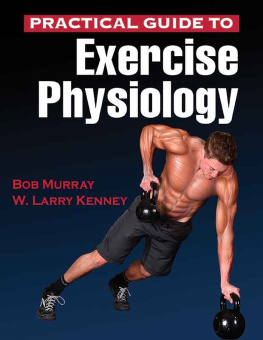Developing Your Own Exercise Program
A simplistic exercise science approach
William Daniels
Developing Your Own Exercise Program
All Rights Reserved
Copyright 2012 William Daniels
All Rights Reserved .This book may not be reproduced, transmitted, or stored in whole or in part by any means, including graphic, electronic, or mechanical without the express written consent of the publisher except in the case of brief quotations embodied in critical articles and reviews.
Booktango books may be ordered through booksellers or by contacting:
Booktango
1663 Liberty Drive
Bloomington, IN 47403
www.booktango.com
877.445.8822
ISBN: 978-1-4689-1009-4 (ebook)
The most crucial part of losing weight or gaining strength is the ability to create and sustain your own exercise program. In fact, the number one reason for failed weight loss attempts is simply not knowing where to begin, or how to progress. This part is so confusing to most, that they pay hundreds of dollars to a certified professional who spends an hour of their time making a personal exercise program. So whats the problem with this? Well, besides the obvious waste of money, there are several other reasons why this is a horrible approach. First, our lives are so unbelievably unpredictable . Injuries, age, and work often force us to stray off the program we paid top dollar for. Then what? Fork out hundreds more for an updated regimen that you may or may not be able to stick with? Secondly, without understanding the process and reasons for your specific exercises, reps, sets, and rest periods, there is no way to customize it for your changing needs and desires. That is unless of course you pay someone to make a new program for you. As the old saying goes. Give a man a fish and he eats for a day. Teach a man to fish and he eats for a lifetime.
This guide will be as honest, simple, and accurate as possible. All recommendation will come directly from my experience as and exercise scientist and from current American College of Sports Medicine ( ACSM ) guidelines. You will be able to sit down, at any stage of athleticism, age, or weight, and make an appropriate and successful exercise program. Note that any form of exercise has risks. *It is important for you to consult your physician before starting any new exercise program.
The first step to your new body is establishing your fitness goals. The type and number of exercises, as well as the number of sets and repetitions will differ based on your desired outcomes.
Goals | Sets | Reps | Intensity (1RM) | Rest between Sets |
Health/weight loss | | 10-16 | 60-80% | 30-60 seconds |
Muscular Endurance | | 15-25 | 50-65% | 1-2 minutes |
Muscular Strength | | 4-6 | 70-88% | 2-3 minutes |
Size Hypertrophy | | 8-12 | 70-85% | 30-60 seconds |
*These guidelines are the starting point for novice to intermediate level individuals. I recommend that everyone designing their first program start at the lower end of the (1RM) intensity levels. Advanced athletes do not worry, you will rapidly progress into more rewarding and challenging intensities. We will later explain the way to determine your (1RM). For now it is important to understand your goals for this program.
Exercise selection can vary depending on goals and workout structure. There are 3 basic workout structures that I will be discussing: Total-body, Upper/Lower Split, or Muscle Group Split. Determine which works best for your goals
Total-body workouts:
Works great for weight loss programs
Includes 1-2 exercises for each major muscle group (you preference)
Chest/Back/Biceps/Triceps/Hamstrings/Gluteus/Calf/Obliques/Abdominals/Shoulders.
Large muscles should be performed before small!
Exercises involving different muscle groups can be done between sets to decrease workout time. (Circuits) Great for time constraints! Example: You can do a set of chest exercises followed immediately by a set of back exercises. The time spent doing a set of your back exercise is considered the rest period for your first chest set. Go right back to your second set of chest exercise and repeat.
Usually 2-3 days a week
1. Ex: Monday, Wednesday, Friday or Monday, Thursday
2. Allow for 48 hours between each workout
Upper/Lower Split:
More common with bodybuilders and power lifters
Alternate between days of upperbody exercises and lowerbody exercises
2 days a week
1. Ex: Monday, Thursday or Tuesday, Friday or even Monday, Tuesday
Muscle Group Split:
All exercises for a specific muscle group are performed during a workout
Usually requires more than 3 days a week spent in the gym
1. Ex: Monday(Upperback/Chest), Tuesday(Biceps/Shoulders), Wednesday(Triceps/Hamstrings), Thursday(Quads/Lower Back)
Allow for at least 48 hours before doing the same muscle group again
Typically used by bodybuilding programs
Muscle Group Exercise Suggestions:
Sample Exercises |
Upper Back | Lower Back | Chest | Biceps | Triceps | Shoulders | Abdominals | Hamstrings | Quadriceps | Whole Leg |
Seated Rows | Superman | Bench Press | Curls | Dips | Shrugs | Crunches | Leg Curl | Leg Extensions | Leg Presses |
Push-Ups | Trunk Extension | Flys | Hammer Curls | Overhead Extensions | Lateral Raises | Trunk Twists | Squats | Squats |
Pull-Ups | The Plank | Push-Ups | Preacher Curls | Push-Ups | Plank |
Overhead Press | Bicycle |
Total Body | Upper/Lower Split | Muscle Split (Chest/Triceps) |
Squat | Bench Press | Bench Press |
Bench Press | Bent-Over Row | Incline Bench Press |
Lat Pull-down | Incline Dumbbell | Dumbbell Flys |
Leg Press | Seated Row | Cable Cross Over |
Shoulder Press | Lateral Raise | Standing Tricep Extension |
Back Extension | Lying Tricep Extention | Reverse Pushdowns |
Tricep Pushdown | Preacher Curl | Reverse Dips |
Standing Curls |
Standing Calf Raise |
Torso Rotations |
*Routine Examples for Each Structure Type
Determine which program structure works best for your goals and lifestyle
Determine the exercises and days that you will be doing your routines
1. Allow for at least 48 hours rest between workout sessions for each muscle group.
2. Ex: If you have a split muscle structure with chest/back on Monday, you cannot work out chest/back again until at least Wednesday.
3. Work out at least 1 time a week per muscle group.
Determine the order of your exercises on each day following these guidelines
Next page







